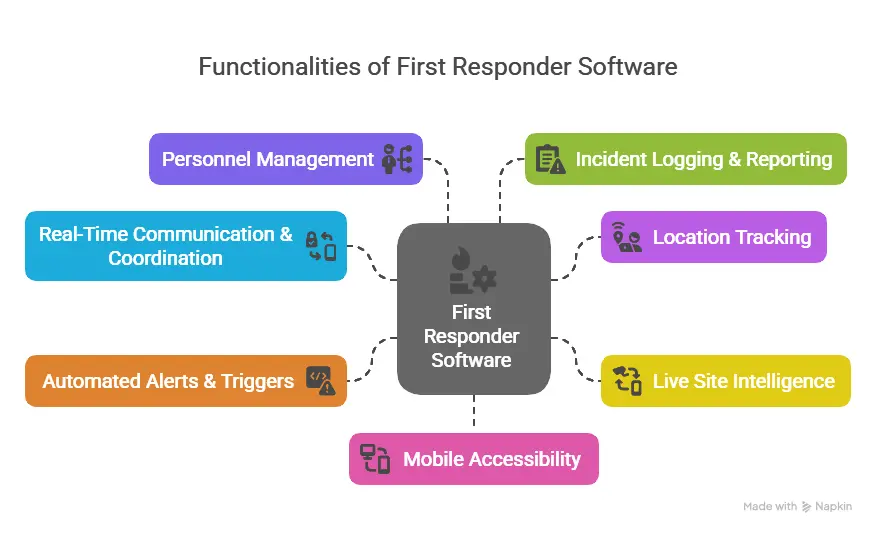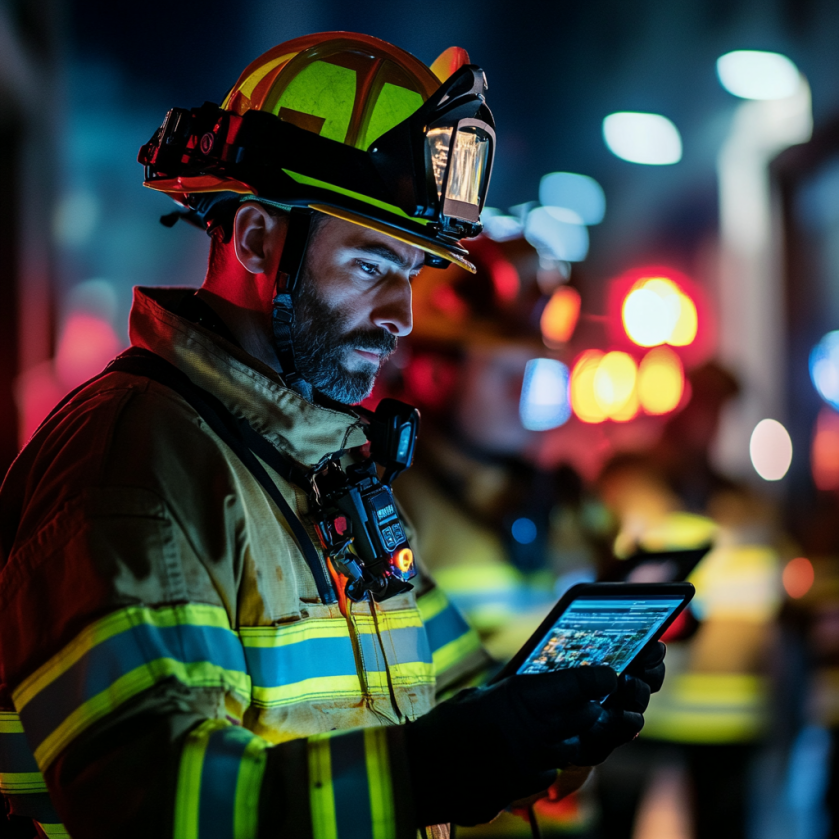In the face of emergencies, seconds count.
Whether it’s a natural disaster, an active shooter incident, or a hazardous material spill, the ability of first responders to act quickly and in unison often means the difference between life and death.
Yet, in the heat of the moment, chaos can often overwhelm communication systems, delay decision-making, and hinder response effectiveness.
At Building Safety Solutions, we believe technology can—and should—bridge that gap.
Our advanced first responder software empowers emergency teams to transition from reactive chaos to coordinated action, ensuring faster, smarter, and safer outcomes for all involved.
Let’s take a closer look.
The Problem: Chaos in Critical Moments
Emergency situations are inherently unpredictable. Disconnected communication systems, outdated information, and the lack of a real-time view of unfolding events can all contribute to operational failures.
Traditional emergency response often relies on verbal radio communication, hand-written notes, or manual dispatching systems that can’t keep pace with high-stakes, rapidly evolving scenarios.
That’s where first responder software steps in—not just as a tool, but as a digital backbone for emergency coordination. In addition, a first responder system is just one of several ways to reduce your business’s legal risks during workplace incidents.
The Solution: What First Responder Software Can Do
First responder software integrates real-time location tracking, incident data aggregation, automated communication, and interactive site maps to provide first responders and command centers with a unified view of a crisis.
Key features include:
- Live Personnel Tracking: Know where every responder is at any given moment.
- Secure Communication Channels: Instantly share updates, images, and voice messages without relying on traditional dispatch or radio chatter.
- Dynamic Building Layouts: Access site-specific and interactive floor-plan maps, exit routes, and hazard zones in real time.
- Integration with Alarm and Sensor Systems: Automatically detect threats such as fire, smoke, or chemical leaks.
- After-Action Reporting: Automatically log every action taken for review, training, and legal documentation.
What Exactly Does First Responder Software Do?
First responder software is designed to help emergency personnel—like police, firefighters, paramedics, and incident command teams—respond faster, coordinate more effectively, and make better decisions during crises.

Here’s a breakdown of what first responder software actually does:
🔹 1. Real-Time Communication & Coordination
- Replaces or supplements traditional radios with secure, encrypted messaging.
- Enables direct communication between field teams and command centers.
- Supports multi-agency collaboration (e.g., police and fire departments sharing the same digital incident board).
🔹 2. Location Tracking
- GPS tracking shows exactly where each responder is.
- Helps avoid duplication of effort and improves accountability.
- Allows incident commanders to reposition teams based on evolving threats.
🔹 3. Live Site Intelligence
- Displays building floorplans, utility shut-offs, hazardous zones, and more.
- Updates dynamically as new intel comes in (e.g., from security cameras or IoT sensors).
- Helps responders navigate unfamiliar environments safely.
🔹 4. Automated Alerts & Triggers
- Integrates with fire alarms, panic buttons, chemical sensors, etc.
- Triggers instant alerts with location data.
- Can lock down zones or open emergency exits remotely.
🔹 5. Personnel Management
- Tracks who is on duty, who is responding, and who is unaccounted for.
- Helps ensure proper staffing and manage shift rotations in prolonged incidents.
🔹 6. Incident Logging & Reporting
- Automatically records communications, actions taken, and timelines.
- Generates after-action reports for legal, training, or insurance purposes.
- Simplifies compliance with regulatory requirements (e.g., OSHA, FEMA).
🔹 7. Mobile Accessibility
- Most platforms run on smartphones, tablets, and ruggedized field devices.
- Offers real-time updates to responders even while they’re en route.
In short, first responder software replaces chaos with clarity. It doesn’t just speed up response—it makes every second count more effectively.
How Does a Company Install or Implement First Responder Software?
Implementing first responder software in a company or organization—especially one responsible for public safety or large facilities—requires thoughtful planning and a collaborative rollout.
Here’s a breakdown of how the process typically works:
1. Needs Assessment & Site Evaluation
- Goal: Understand your organization’s risks, emergency protocols, and infrastructure.
- What happens:
- Conduct interviews with safety managers, facility directors, IT staff, and local emergency services.
- Identify physical locations to be mapped (e.g., buildings, campuses, warehouses).
- Pinpoint vulnerabilities (e.g., lack of communication between departments or outdated evacuation plans).
2. Platform Customization
- Goal: Tailor the software to your facility, emergency types, and communication style.
- What happens:
- Upload building schematics, floor plans, and emergency exits.
- Set up organizational hierarchies (e.g., who gets alerts, who manages incident logs).
- Integrate with existing systems—like alarms, access control, surveillance, or mass notification platforms.
3. Hardware & Connectivity Setup
- Goal: Ensure reliable access in all environments.
- What happens:
- Deploy software on mobile devices, workstations, tablets, or dedicated command consoles.
- Optional: Install supporting hardware like panic buttons, beacon sensors, or wireless routers in key areas.
- Set up fallback systems (e.g., offline operation modes in case of network failure).
4. Integration with First Responder Agencies
- Goal: Connect your system with external responders like fire, police, and EMS.
- What happens:
- Provide responders with secure access to your digital emergency dashboard.
- Share building layouts, hazardous materials information, and occupant rosters.
- Establish joint response protocols (e.g., shared channels during an active threat).
5. Training & Drills
- Goal: Get everyone comfortable with the system before a real emergency.
- What happens:
- Conduct training sessions for employees, security teams, and facilities staff.
- Run live simulations (e.g., fire drills, lockdown scenarios) using the software.
- Provide refresher courses and role-based training (e.g., admin vs. general staff).
6. Ongoing Maintenance & Support
- Goal: Keep the system up to date and reliable.
- What happens:
- Regularly update software with new features and security patches.
- Audit logs and user activity for compliance and effectiveness.
- Maintain a relationship with your software provider for troubleshooting and upgrades.
What Are Some Other Smart Implementation Tips?
- Involve IT early to avoid firewall or access control issues.
- Assign champions within each department who can advocate for and train others.
- Sync with local authorities to ensure a seamless public-private response strategy.
- Don’t overload with features at first—start with the essentials and scale up.
So, we know the importance of implementing a first responder software system into your building’s safety plan structure.
Now, let’s look at a few hypothetical but realistic case studies that show how this emergency management technology can be a game-changer.
Case Study 1: Coordinating During a Multi-Agency Wildfire Response
Scenario: A fast-moving wildfire in a suburban area required immediate evacuation and fire suppression across multiple neighborhoods. Firefighters, police, and paramedics from various jurisdictions were deployed.
Problem: Agencies used different communication systems, leading to confusion over which zones were cleared and which remained at risk.
How First Responder Software Helped:
- Using first responder software, all agencies were able to log into a shared incident dashboard accessible from mobile and vehicle-mounted devices.
- Evacuation statuses were updated in real time, visible to everyone on the ground.
- Fire progression data, pulled in from satellite and drone feeds, allowed responders to reposition ahead of dangerous wind shifts.
Outcome: Zero responder injuries and the evacuation of over 3,000 residents with no fatalities. A post-incident review found that response coordination time was cut by 40% compared to similar past events.
Case Study 2: Active Shooter at a Corporate Campus
Scenario: An active shooter situation unfolded in a large corporate office complex during business hours.
Problem: 911 was flooded with duplicate calls, and arriving police lacked a real-time view of the interior layout and occupant status.
How First Responder Software Helped:
- The company’s subscription to Building Safety Solutions included pre-loaded, interactive building schematics accessible by first responders.
- Employees used a panic alert feature within the mobile app, tagging their locations and sending silent updates.
- Command staff routed law enforcement to where survivors were sheltering based on real-time app signals.
Outcome: With active shooter preparedness software in place, police were able to neutralize the threat within 12 minutes of arrival and safely evacuate employees from isolated sections without further casualties.
Case Study 3: Hazardous Chemical Spill at a Manufacturing Facility
Scenario: A valve malfunction at a plastics manufacturing plant released a dangerous chemical gas.
Problem: Employees fled in all directions, and hazmat responders had no idea who remained inside or where the leak originated.
How First Responder Software Helped:
- Internal sensors detected the chemical and automatically triggered an alarm via the Building Safety Solutions system.
- The software immediately locked down air handling systems and created a digital hazard zone based on airflow patterns.
- Response teams received a list of personnel unaccounted for based on badge swipes and GPS location data.
Outcome: Two employees were rescued from a locked storage room within minutes, and the leak was contained rapidly. OSHA later praised the company’s preparedness and use of smart emergency response software.
Why Building Safety Solutions?
We’re more than a software provider—we’re a partner in emergency readiness. Our platform is built with input from firefighters, EMTs, law enforcement, safety officers, and emergency managers. It’s customizable, scalable, and designed to meet the real-world demands of those on the front lines.
Our mission is simple: to reduce liability, protect lives, and promote continuity in the face of disaster. Whether you manage a school district, hospital system, corporate office, or industrial site, Building Safety Solutions can help turn your emergency plan from a static binder into a dynamic, life-saving tool.
Ready to Bridge the Gap?
If you’re still relying on outdated systems—or worse, hoping emergencies won’t happen—it’s time to rethink your preparedness strategy. Contact us today for a live demo or to learn how Building Safety Solutions can enhance your emergency response operations.
Let’s turn chaos into coordination—together.
✔️ What Building Safety Solutions Offers
At Building Safety Solutions, we make this process seamless. Our onboarding package includes:
- Site mapping and software setup
- Guided integration with existing safety infrastructure
- First responder liaison coordination
- In-person or virtual training
- 24/7 support with real-time troubleshooting
Here’s a clear and professional First Responder Software Implementation Checklist designed specifically for building safety managers. You can use this to guide your organization through a smooth setup and rollout process:
✅ First Responder Software Implementation Checklist
For Building Safety Managers
Click here for a printable version of this software implementation checklist (INTERNAL NOTE: THIS WILL LINK TO A PDF CHECKLIST OF WHAT YOU SEE BELOW)
🔍 1. Pre-Implementation Planning
- Identify internal stakeholders (e.g., facilities, IT, security, HR).
- Schedule a kickoff meeting with software provider.
- Review current emergency response plans and protocols.
- Assess physical site layout and emergency vulnerabilities.
- Gather digital files: floorplans, evacuation maps, safety documentation.
🛠 2. Software Setup & Customization
- Upload building schematics into the platform.
- Configure user access levels (admin, staff, responders).
- Integrate with:
- Fire alarms
- Surveillance systems
- Door access control
- Mass notification systems (email/text/PA)
- Establish alert zones and geofences.
🌐 3. IT & Connectivity Readiness
- Verify network access for all devices (Wi-Fi/Cellular).
- Install mobile app or desktop platform on all key user devices.
- Conduct firewall and security compatibility checks with IT.
- Enable offline mode or backup communication protocols.
🚓 4. First Responder Coordination
- Invite local emergency responders to access shared dashboards.
- Provide digital building maps and occupancy data to agencies.
- Schedule coordination meeting or joint training drill.
- Set emergency contact protocols between company and responders.
🎓 5. Staff Training & Simulation
- Deliver system training to:
- Frontline workers
- Management
- Emergency response teams
- Schedule quarterly emergency drills using the platform.
- Collect feedback and make necessary adjustments.
- Ensure signage or instructions are posted near exits or high-risk zones.
🔁 6. Ongoing Maintenance & Updates
- Schedule periodic system updates and data backups.
- Conduct monthly functionality checks (alerts, sensors, tracking).
- Assign internal system administrator for oversight.
- Review after-action reports from drills or real events.
- Coordinate annual refresh training for all users.
🗂 Optional Documentation (Attach/Link as Needed)
- Emergency floorplans
- Staff contact lists
- Hazardous material inventory (if applicable)
- Vendor support contacts
- Training logs and drill reports
🧭 Pro Tip from Building Safety Solutions:
Keep a printed version of this checklist with your emergency documentation and update it after every drill or software change.



